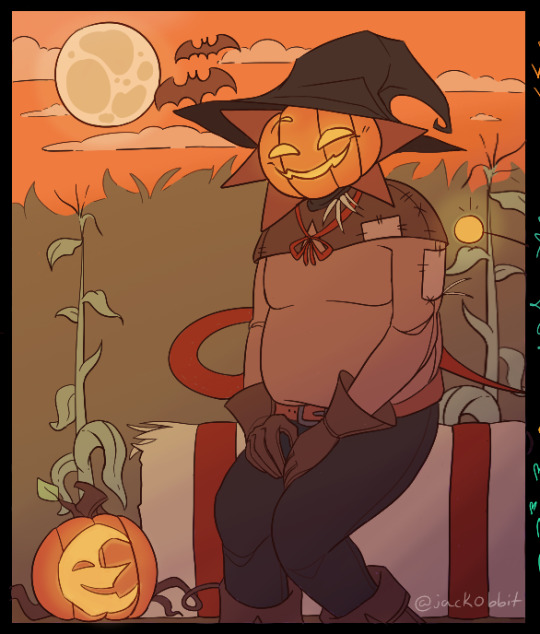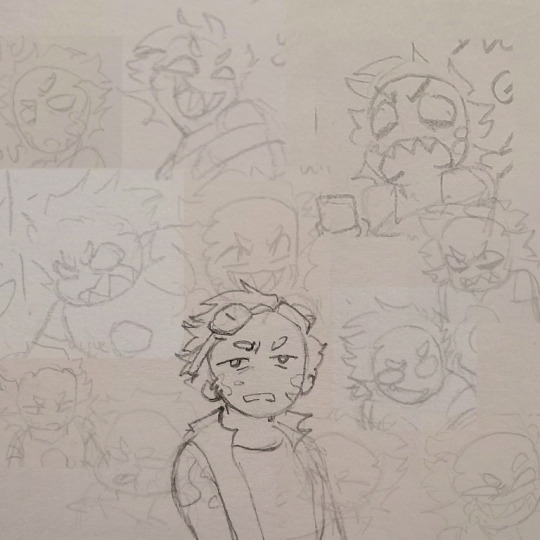#ATCC
Explore tagged Tumblr posts
Note
The gang’s thoughts on women?


We at chimera crew headquarters support kissing women 👍
(Art by @thebluelittlewitch / @wannabemasterofwindintraining)
13 notes
·
View notes
Text
guess it's time to make a post about this because i realize i never actually did... so yeah ! uhm, ATCC was a... thing, and it's most likely the thing that many of my followers now remember me for (and if you're out of loop with it, ATCC or @ask-the-creative-crew was a DHMIS centered ask blog i made back in the year 2022), and it's been a hot minute since i've touched on it.
originally, i stopped posting because i was still in the school at the time and the blog was something i did on the side for fun. it only ever came to fruition because i wanted another place to show off my designs and headcanons other than instagram (RIP to the gram though). my intent for it then was just to be a silly thing that had no "heavy" storyline to it other than a bunch of little guys all hanging out together.
some time later, the TV show released and changed my perspective on a lot of the characters as well as the story (which i had begun to build whenever i was taking long breaks). fast forward 2 years and some emotional growth and artistic improvement - much of the story and character designs/personalities/relationships have evolved to fit the new narrative i've built. a lot of change has happened and will most likely keep happening as long as B&J keep producing the show and giving us new content to work with.
i mention all of this because a lot of what's on the blog (or what little of it was even there to begin with) doesn't exactly align with what i have now. i don't want to say it's dead forever and ever, but rather in an indefinite limbo while i try to figure out how i want to go about sharing the new story. i tend to be a little cryptic when sharing details about what it's like now because things are still susceptible to change, and also because i don't want to reveal the whole thing yet, but i really am more than happy to answer any questions you guys have about it (just don't always expect me to provide art if i answer. i'll give you rabies if you beg. rawr).
it does kind of hit a soft spot in my heart to know there are still people interested in my goofy little interpretations. thank you to everyone who's been supporting me after all these years, and for reading my ridiculously long explanation. have a cookie. 🍪
24 notes
·
View notes
Text



i love when the animators know to put the correct amount of deep abiding sorrow in him
#my dearest and most beloved favorite character. my god#every time i sketch obi-wan he has to look like he carries planets worth of sadness on his shoulders#aughdhh#obi wan kenobi#tales of the underworld spoilers#atcc#obi-wan tag
6 notes
·
View notes
Text
The AI-Based Traffic Management System, Enabling Sustainable Urban Mobility
Introduction: Smart Traffic, Smarter Cities
Urban mobility is undergoing a silent revolution. Not through flying cars or teleportation, but through the invisible brain powering our roads, Artificial Intelligence. As cities buckle under the weight of rising vehicle numbers, pollution, and congestion, the solution isn’t to just build more roads, it’s to manage the ones we have better.
That’s exactly what an AI-based traffic management system is doing. By using machine learning, computer vision, and real-time data analytics, it’s transforming chaotic, carbon-heavy roadways into sustainable, intelligent ecosystems.
The future of urban mobility isn’t just about moving faster. It’s about moving smarter, cleaner, and more efficiently. And AI is leading the charge.
The Sustainability Crisis on Urban Roads
Urban roads are a major source of environmental degradation:
Traffic congestion increases idle times, wasting fuel and emitting CO₂.
Inefficient traffic lights force vehicles to stop-start, accelerating wear and tear.
Manual traffic enforcement lacks scale and consistency, leading to non-compliance.
Infrastructure decisions are often based on outdated or anecdotal data.
The result? Pollution, inefficiency, and frustration. It’s clear: our cities need more than expansion. They need optimization. Enter the intelligent traffic management system.
How AI Enables Sustainable Mobility
Let’s break down how an AI-based traffic management system directly supports sustainability goals:
1. Reducing Congestion, Minimizing Emissions
AI analyzes real-time traffic patterns using data from:
CCTV cameras
GPS trackers
Connected vehicle data
Automatic traffic counting systems
It then:
Optimizes traffic signal cycles
Re-routes traffic to avoid congested areas
Suggests alternate corridors for better flow
By doing this, stop-and-go driving is reduced, leading to:
Lower fuel consumption
Reduced carbon emissions
Improved air quality
In smart cities, AI isn’t just moving cars. It’s cleaning the air.
2. Intelligent Public Transport Integration
A smart traffic management system also:
Gives signal priority to buses and trams
Tracks real-time locations of public vehicles
Adjusts traffic flows around transit hubs
The result? More reliable public transport, which encourages people to switch from private vehicles, key to reducing urban carbon footprints.
3. Violation Detection Without Manual Policing
Traditional enforcement consumes fuel, manpower, and time. AI systems use video analytics to automatically detect:
Speeding
Helmet and seatbelt non-compliance
Wrong-lane usage
Illegal parking or idling
Each violation is captured, logged, and acted upon without human intervention. This reduces:
Fuel used by patrol vehicles
Paper-based ticketing processes
Corruption and inconsistencies
It’s a paperless, low-emission law enforcement model.
4. Adaptive Traffic Signals Based on Demand
Gone are the days of fixed-timer signals. With AI:
Traffic lights adjust based on vehicle load
Pedestrian signals adapt based on foot traffic
Emergency vehicles are given green corridors
This creates a fluid, responsive city grid that minimizes idle time, conserves fuel, and enhances road efficiency.
Supporting Technologies in the AI Ecosystem
Several technologies empower this green transformation:
a. Automatic Traffic Counting and Classification (ATCC)
Categorizes vehicles (bikes, cars, trucks, buses) to understand road usage trends. Helps with:
Planning low-emission zones
Creating EV-only lanes
Regulating freight timings for off-peak hours
b. Video Incident Detection System (VIDS)
Identifies roadblocks, accidents, or stalled vehicles, clearing them quickly to prevent idling and congestion.
c. Automatic Number Plate Recognition (ANPR)
Facilitates congestion pricing and toll collection without stopping vehicles. Seamless movement means less fuel burnt at barriers.
d. Speed Detection Systems
Enforce eco-speed limits that minimize aggressive acceleration and braking—both major fuel wasters.
Enabling Green Urban Planning
AI traffic data is invaluable to city planners:
Identify high-emission corridors for greening or congestion tolls
Pinpoint pedestrian-heavy zones to pedestrianize streets
Forecast road deterioration and plan timely, eco-friendly maintenance
The intelligent traffic management system thus becomes a decision-making tool, not just for traffic departments, but for sustainability officers and urban planners.
Encouraging the Electric Vehicle Ecosystem
AI traffic systems are future-ready for EV integration. They help by:
Prioritizing EVs at intersections
Mapping optimal routes based on charge levels and charging station density
Managing grid demand by analyzing vehicle flows near stations
As EVs rise, AI ensures they’re not just adopt, but adopted smartly.
Public Benefits of AI-Driven Sustainable Mobility
✅ Cleaner Air
Reduced congestion = fewer emissions = healthier cities.
✅ Less Noise Pollution
Smoother traffic means less honking, braking, and engine revving.
✅ Fuel Savings
For both public and private vehicle owners.
✅ Increased Use of Public Transport
Reliability and speed make it the preferred choice.
✅ Data-Driven Urban Planning
Better roads, smarter zoning, and efficient logistics planning.
Challenges on the Path to Sustainability
While promising, implementation isn’t plug-and-play. Cities must address:
Infrastructure gaps in older road systems
Privacy concerns regarding vehicle tracking
Integration with legacy systems
Public buy-in for data-driven enforcement
However, these can be solved through pilot programs, stakeholder education, and transparent policy-making.
Global Examples of AI Driving Sustainability
Singapore: Dynamic congestion pricing and AI-managed intersections
Amsterdam: Eco-routing for delivery fleets
Barcelona: Smart pedestrian signals synced with traffic flow
These cities are living proof that green mobility is not a dream, it’s a data-driven reality.
The Road Ahead: AI as Urban Sustainability Catalyst
What’s next for AI in sustainable transport?
Predictive emissions modeling for future construction
AI-assisted EV traffic zones that adapt by time of day
Carbon credit integrations for green driving behavior
AI-powered traffic gamification to reward sustainable choices
The future isn’t just smart, it’s green, adaptive, and ethical.
Conclusion: Cleaner Cities Start With Smarter Traffic
In the face of climate change, cities can’t afford to treat traffic as a standalone problem. It’s a sustainability issue, an environmental issue, and a quality-of-life issue.
An AI-based traffic management system is the key to transforming our roads from smoke-belching bottlenecks to seamless, sustainable arteries of progress. With real-time optimization, data-driven policy, and zero-tolerance enforcement, AI isn’t just managing movement. It’s reshaping urban life.
Because a city that breathes better, lives better.
#anpr#roadsafety#analytics#trafficmanagement#smartcity#urbanmobility#vehicle#atcc#ai based traffic management#ai traffic management
0 notes
Text
Radar to the Rescue
Rain, fog, or shine—radar-based Automatic Traffic Counting and Classification systems deliver unmatched precision. Radar detects speed, size, and movement, ensuring accurate vehicle data even when visibility drops. Cities can count on ATCC to never miss a vehicle, regardless of the weather. That’s traffic tech that doesn’t take a day off.
0 notes
Text
Why Smarter AI Traffic Management Is Essential Today

In today’s fast-paced urban environment, managing traffic with outdated systems leads to congestion, delays, and safety concerns. An AI-based traffic management system offers a smarter alternative using real-time data, machine learning, and computer vision to make roads safer and more efficient.
As a part of this evolution, Recon, a next-gen intelligent traffic management system, stands out. One of its key innovations is the Video Incident Detection and Enforcement System, which uses AI-powered video analytics to instantly detect incidents like stalled vehicles, wrong-way driving, and lane violations. It enables real-time alerts and automated enforcement, helping reduce response time and enhance road safety.
With the growing complexity of urban traffic, AI traffic management is no longer optional; it’s essential for building smarter, safer, and more responsive cities.
#ai-based traffic management systems#anpr#atcc#automatic number plate recognition#plate type detection#ai-powered technologies#number plate detection#automatic traffic counting and classification
0 notes
Text
Alrighty, here we go, one last time!
We’ve got some feesh, and this pumpkin fella I’ve been rotating in my brain all week. (I do apologize for the low quality on that last one especially, I had to rush at the end bc I had some other stuff to do)
With this, the week of au’s Magma event is over! It was super fun to to draw everyday with other folks! Seeing everyone else’s art was a real treat.
It also provided a nice challenge! It really did help me learn a lot, but, I think I’m ready to use my usual programs again lmao

[ID: A Magma drawing of a Mer Sun and Mer Moon underwater, they are both placed against a blue-green background with both Sun and Moon being drawn slightly outside of the colored box. Mer Sun is yellow and orange with lots of dark brown spots, he waves his arms up and down quickly as he looks up and to the right at Moon who floats overhead. He is smiling brightly. Moon looks down at Sun with a smile, one hand is stretched out towards Sun while his other is kept in a fist near his chest. Moon is colored a mix of greys and blues with brighter electric blue spots. /End ID]

[ID: A Magma drawing of a Halloween version of Sun sitting on a hay bale within a corn field. He has a pumpkin for a head, and wooden sun-like rays. He wears a witch’s hat, a burlap shirt, black pants, gloves, a belt and boots. He smiles, looking off into the distance. Next to him is a small pumpkin on the ground, carved to resemble a grinning crescent moon. The background consists of an orange sky, clouds, a full moon and two bats flying in the sky. /End ID]
#fnaf dca#fnaf daycare attendant#fnaf moon#moondrop#fnaf sun#sundrop#dca au#fnaf au#fnaf#dca fandom#my art#it’s like. five in the morning as I type this so I think I’ll just post this early#I’m also not gonna lie#I might keep Pumpkin sun#filling in the blanks on his AU was comically easy#even got an idea for moon too#I lob himb#At the Crows Call#AtCC Sun#Mer au#Mer sun#Mer moon
76 notes
·
View notes
Text
All Things Concerning Chaos: Main Cast
(An "A" beside the name denotes an Antagonist)

Aelyn
Born into a chaos worshiping cult that lives below Icarus. Was raised and shaped to be the next leader, and decided to leave gender behind in the process. Was sent out to track the group to find their deity who was recently released.
Darien (A)
From the same cult as Aelyn. Volatile and very angry about being passed up as leader - he will meet Chaos for himself and have his word be law.
El
Secondary doctor to Monty's primary position and lives in a plague-ridden town that barely has anyone left. There's a lot about El that he doesn't want people to know, but boy he do love him wife.
Eva
Prodigy mechanic and automaton maker that lives in Icarus with her adoptive mother. Creator of Ferro and Dog - though people are not sure how she was able to make her personal automatons so much more advanced than normal.
Ferro & Dog
Eva's most advanced creations - to the point of them being considered sentient. This is due to Eva's magic. Dog has had to be "reupped" a couple of different times. Losing all the training and memories from before each time. Ferro is far more advanced and hasn't had to be "reupped" yet. Though he is terrified for when that happens as he doesn't want to lose himself.
Julius
The head of the Wings of Icarus and acts as chaperone to the group to make sure they do what they're supposed to do. Frequently bickers with Markus.
Lila (A)
Eva's mirror twin. Was thrown into an asylum at four years old after an incident in the square where she broke down. With no one to claim her that is where she has stayed for the past decade. Reportedly.
Lucy
El's wife and former asylum inmate before the big breakout. Very proper, very calculating, very unnerving.
Magdelena
Holds herself very poised, but coiled like a snake. The adoptive mother of Eva and dragged into things by her ex-lover, Markus. Supplies Eva with metals to use when she can due to her own witchly magic.
Markus
Tall, attractive, and an absolute dillpickle. Markus is the one who accidentally unleashes Chaos after touching the jewel and names his ex - Maggie - as conspirator to drag her down with him. Ringleader of the traveling Circus Troupe/Thieves Ring. (I feel like it's important to note that Markus hasn't seen Maggie in near a decade.)
Monty
Sadness masked with a blanket of waning hope and determination that barely helps keep him alive. Primary doctor of a town that's slowly dying to the plague.
Scarlette
Rarely seen without her trademark red lipstick - Scarlette is another ex-lover of Maggie's due to a huge misunderstanding between the two of them. She cares so much for Eva (and only Eva, according to her) that she goes along to help the group so they don't die to the prison collars.
Sophia
Markus' confidant and acts as a knife-throwing tattooed woman in the circus. Was also caught in the theft, but was not the one who touched the jewel.
Vienna
Another one of Markus' troupe that was captured that night. A gremlin by nature, she uses her small form and high energy to use as a grave robber and pickpocket. Has a problem with the drink.

Taglist: @satohqbanana || @thebejeweledwatercat || @steh-lar-uh-nuhs || @drawnecromancy
28 notes
·
View notes
Text
I use booklive to buy jp manga that haven’t been licensed & ridi to buy kr wns/novels that haven’t been licensed… mr blue for kr webtoons I think because it was the only platform my bias was on for a while… I still have jjwxc for cn wns and maoer for audio dramas but I haven’t checked out cn wns/audio dramas in a while… I do want to support the artists and also this helps me keep track of What Are My Absolute Faves in case I forget the titles
#orlbs#misclb#sometimes I also just impulse buy smth thats already been licensed…#I have atcc on mr blue I think…#did I buy atcc twice…?#I wish I was into spreadsheets#I want a catalog of my phys books and digital media#maybe later this year
2 notes
·
View notes
Video
youtube
AI Based Traffic Management Systems Transforming Highways Beyond Traffic Control
AI-Based Traffic Management Systems are revolutionizing urban mobility by leveraging advanced technologies like machine learning, predictive analytics, computer vision, and NLP. These systems optimize traffic flow, detect violations, and enhance road safety in real-time. From AI-powered vehicle counting and classification to predictive traffic analytics and ANPR-based enforcement, smart traffic management ensures smoother and more efficient transportation networks.
In this video, we’ll explore: ✅ Key technologies in AI-driven traffic control ✅ Real-world applications and case studies ✅ How AI is reducing congestion and improving road safety ✅ The future of smart city traffic management
Watch now to discover how AI is shaping the future of transportation! 🚦🔍
🔔 Subscribe for more insights on AI and smart city solutions!
#youtube#AIBasedTrafficManagementSystems#AIPoweredTechnologies#NumberPlateDetection#ViolationDetection#AutomaticTrafficCountingandClassification#AutomaticNumberPlateRecognition#PlateTypeDetection#ANPR ATCC#RoadSafety#SmartCities#TrafficManagement#AI
0 notes
Note
What is Cherry’s LEAST favorite fish


Sounds like there's a lot of baggage here
Art by @thebluelittlewitch2-thesequel
25 notes
·
View notes
Text

Everyone knows that. 🏡📅
#🎨🖌#dhmis#don't hug me i'm scared#dhmis lesley#dhmis roy#happy june 19th you crazy critters.#there is actually a little atcc lore in here... if you squint.
1K notes
·
View notes
Text
It's back in the planning phase after being shelved for a couple of years, but I'm working on putting physical words to a story I've been developing with my partner called All Things Concerning Chaos!
Cursed capitalism in a city that reaches the skies, Witches and the real threat of Witch Hunts, cults that live deep underground, circus's that are not what they seem, looming war on the horizon, and protagonists that are all very, very flawed. I was working on some worldbuilding stuffs last night actually!




okay so every couple of weeks i have the thought 'wow people dont reblog writing like they used too anymore' and it's true but what's the point in having that thought and doing nothing to change it?
you all should reblog this post and share some of your writing or art or moodboards or fun facts off of it! give me something to look at and reblog!
even better, try and check out the notes once this gets spreading, and do the same!
544 notes
·
View notes
Text
Radar to the Rescue
Rain, fog, or shine—radar-based Automatic Traffic Counting and Classification systems deliver unmatched precision. Radar detects speed, size, and movement, ensuring accurate vehicle data even when visibility drops. Cities can count on ATCC to never miss a vehicle, regardless of the weather. That’s traffic tech that doesn’t take a day off.
0 notes
Text
AI-based traffic management systems are intelligent platforms that use artificial intelligence, machine learning, and video analytics to manage, monitor, and control traffic and vehicle-related operations.
These systems are designed not just to detect and respond, but to predict and prevent. They work around the clock, analyzing millions of data points in real time—something no human traffic officer could ever do alone.
Two standout technologies making a huge impact in this space are GateGuard and Recon.
#ai-based traffic management systems#anpr#atcc#automatic number plate recognition#plate type detection#number plate detection#ai-powered technologies#ai#automatic traffic counting and classification
0 notes
Text

If I could go to any race in history it would probably be Macau 91, Only time the top gr.A teams raced each other. DTM vs JTC vs ATCC
178 notes
·
View notes